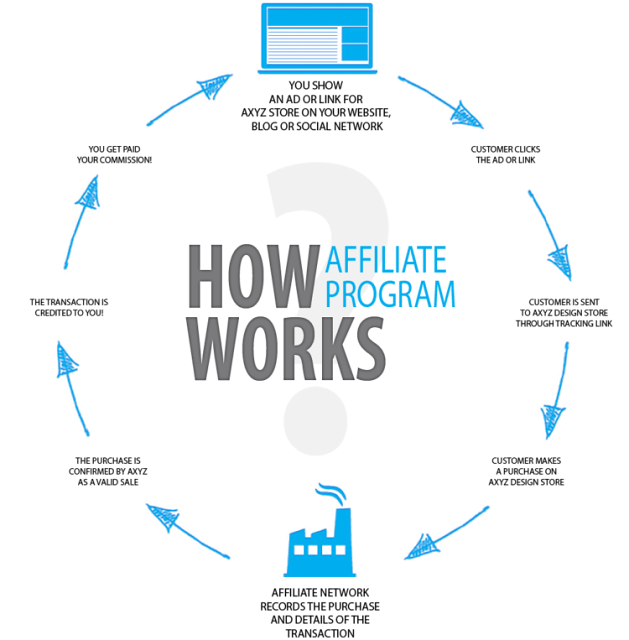
Affiliate Marketers act like a salesforce for a business.
Marketing can be a costly investment for businesses. Big investments into advertising can be an elevated risk if you do not know the return.
Would it not be great if someone else better at marketing took up that risk and funded the marketing?
You could pay them a small commission fee for each sale. It may sound too good to be true, but it is not. This is called affiliate marketing.
This article explores affiliate marketing, how it works and the benefit it provides to both the seller and the affiliate marketer.
What is Affiliate Marketing?
Affiliate marketing is an endorsement-based advertising strategy, that earns promoters (affiliate) money when internet users act on that marketing.
Based on a model of revenue sharing, vendors (merchant) offer a financial incentive such as a commission, through an affiliate program. Affiliates earn a piece of the profit for each sale through creating marketing content to try redirect customers through a customer URL to the merchant’s product.
Affiliates can make money promoting products and services and make an income, without actually having any of their own.
For the merchant, it employs the help of affiliate to invest time and money into marketing your products or services. to expand their reach on the target (online) audience.
According to Mediakix, affiliate marketing spending increases every year in the USA, with around a 10 percent yearly increase in affiliate marketing spending.
Affiliate marketing refers to an online relationship between the so-called merchant and the affiliate, where the merchant pays the affiliate a commission to redirect potential consumers to the merchant’s website (Libai et al., 2003).
How Affiliate Marketing works
Affiliate marketing involves four different parties:
• The merchant,
• The affiliate,
• The affiliate marketing network, and
• The customer.
From a marketing point of view, there are two components: the merchant who has produced the product or service for sale and the affiliate marketer who promotes it.
With a traditional business model, the seller bears the risk that profit exceeds the overall marketing costs. However, an affiliate takes on the promotion efforts and then earns a piece of the profit from each sale they make. This is usually via a predefined commission, and the sales are tracked via personalised affiliate links.
For the affiliate, they just need to be good at marketing. It works similarly to somebody employed in sales on commission. Such as real estate agents. This incentivises their performance. This is a huge benefit to the merchant having a purely commissioned sales force and predictable marketing costs.
In the other hand, affiliates can create a revenue stream without investing in inventory or infrastructure.
“The key to successful affiliate marketing lies in the construction of a win-win relationship between the advertiser and the affiliate.” (Duffy, 2005)
1. The merchant
The merchant is also known as the seller, vendor, or retailer. They are the party who created the product to market — it could be a physical object or a service. They could be a sole trader or a large corporation. Once the product is created, they are not required to be actively involved in marketing. They have others do the promotion, in exchange for a commission on sales.
2. The affiliate
Also known as the content creator or the publisher, the affiliates try to create appealing marketing to attract customers to the merchant’s website. They create content for the products to share on social media, blogs, and websites.
Affiliates often already have an audience or following on social media, so they choose products in their niche that meet the needs of their audience. For example, If I had built an audience posting content about fitness and health, I would not become an affiliate marketer for a candy company.
“There are thousands of affiliates, working for many different advertisers simultaneously, driving incremental traffic and sales in exchange for commission.” (Duffy, 2005)
3. The network
Many merchant/affiliate relationships are managed through affiliate marketing networks. There are two key relationships: The first is with the affiliate and the second is with the merchant. The network works as an intermediary between the merchant and the affiliate.
Affiliate marketing networks such as Linkshare, Commission Junction, and Clickbank facilitate the tracking of sales transactions, payments and product delivery. Their technology tracks all the activities and manages the commissions and the issuance of payments to affiliates.
These networks also serve as a database of products, out of which the affiliate can choose products or services to promote. The network facilitates the management of applicants, making the process of participation easy for both the merchant and the affiliate.
Amazon also has an affiliate network (Amazon Associates Affiliates Program), to help promote consumer products such as books and toys, sold on their platform.
4. The consumer
The consumer (or customer) make this relationship work. If they do not purchase, there is no revenue and the affiliate will not receive a commission. When consumers buy the product, the seller and the affiliate share in the profits.
There will not be a higher price for consumers purchasing through an affiliate, as the cost of the affiliate network is typically included in the price.
The benefits of affiliate marketing
Affiliate marketing is beneficial to both the merchant and the affiliate. The relationship spreads the responsibilities of marketing, leveraging the abilities of a variety of individuals for a more effective marketing strategy.
For the affiliate, it is an inexpensive method of making money with little overheads. It allows digital marketers to make money as free agents for a variety of merchants. The affiliate gets a share of the profit and the merchant benefits from predictable marketing costs as a percentage of sales.
“The strategy represents the ultimate in genuine pay for performance marketing and, as a result, represents one of the most promising long-term marketing strategies for e-commerce.” (Duffy, 2005).
How do affiliates get paid?
Affiliates receive a commission payment from the merchant, depending on predefined consumer actions. These include Pay per click — redirect of a consumer, such as a click-out to their online shop for a lead; or they might Pay per sale if a transaction takes place.
The affiliate’s share of the profit is included in the retail price — there is not an extra fee placed on the customer for a sale through affiliates. Customised affiliate URLs created by the affiliate marketing company or network for each affiliate, to track their sales.
“Each time a sale is made using the affiliate URLs, the merchant pays the content creator a cut of the sale through the affiliate marketing company.” (Mathur, Narayanan, & Chetty, 2018).
Merchant Strategy
Assume you already have a product or service to sell and there is a market for it. Merchants find affiliates, often through an affiliate network, to promote their product or service.
The difficult part for the merchant is finding an affiliate who already have an engaged audience, that matches their target market.
The commission amount positively affects the number of leads. The affiliate will work harder on their marketing. For digital products, because they are easily replicable, commission rates can be 50% or even higher.
“Affiliates place a variety of different kinds of ads on their websites (banners, text ads, even product links) that motivate consumers (website visitors) to take an action to review and potentially buy a product or service from the advertiser. When it works, the affiliate gets paid a commission.” (Duffy, 2005).
Affiliate strategy
Affiliate marketers find a product or numerous products, they like enough that they think is worthwhile promoting it.
Websites such as Gumroad help affiliates to find affiliates to partner with and allow them to collect commissions.
If an affiliate marketer is starting without having a following, they could begin by reviewing products on a YouTube channel or blogging with product reviews and comparisons in their chosen niche. Part of this strategy involves trying to build your contact list by incentivising people to join your mailing list. When an affiliate has an income, using pay per click advertising will help scale up with faster growth.
Merchants should provide their affiliates with various advertising media to suit different applications and to keep fresh in the marketplace. This will improve the results of the affiliates.
“Social media activities showed a significant effect on the number of leads generated by the affiliates. Affiliates predominantly use social media to engage with their target audience. Especially if an affiliate’s business focus is congruent with the merchant’s, affiliates may employ social media messages to draw their audience’s attention to the relevant merchant.” (Olbrich, Schultz, & Bormann, 2019)
Marketing tools
There are several marketing tools that an affiliate marketer can use. Firstly, marketing should be targeted to try and reach the people most likely to be a customer. If you are selling a B2B service, for example, do not use TikTok. Use the methods most likely to reach them. It could be through social media, blogging, email marketing or paid advertising.
If you have chosen a product in a niche that you already have a large email database for or a large social media following, those are the most logical places to start.
It could be a banner on a blog article on your website you wrote to compare products in that category that sends potential buyers to the merchant’s website. You might develop a whole website dedicated to merchant’s products. Search engine optimisation through having sufficiently interesting content to get an adequate number of natural hits.
Social Media
Studies indicate (See (Olbrich, Schultz, & Bormann, 2019) that social media activities of affiliates positively affect the number of ad impressions the number of affiliate leads.

Through social media, affiliates can regularly engage with existing customers and reach new ones through providing meaningful content. Leave links in your email to view social media content that may be valuable to them and have buttons at the bottom of the email to your accounts.
There may be a captive audience on platforms you never even considered, such as Pinterest. So at least have an account on the major social media platforms and repurpose your marketing content you already have, to suit the users on that platform.
Pinterest content will be different from Instagram content for example.
PPC advertising
Once an affiliate is making money via organic (non-paid) lead generation, the next step is paid to advertise. This will drive traffic to their sites.
However, it is important to know and improve your numbers through analysis and optimising ads. The price paid for each click, the conversion rate of those who click through and the average commission need to be considered, which dictates how profitable the advertising is.
“If the value proposition is inadequate for affiliates, it is typically because the advertiser offers a commission percentage that is too low or the conversion rate for customers once they have been directed to the advertiser’s website is too low.” (Duffy, 2005)
Thanks for reading this blog about affiliate marketing.
I hope you enjoyed the content and learnt something new. If you sell products and services online but are struggling to get many results from your marketing, affiliate marketing could be an avenue for you to approach.
This was originally posted on the BYB Marketing Blog: https://brandyourselfbetter.com/blog/post/149397/what-is-affiliate-marketing-and-how-does-it-work


No comments:
Post a Comment